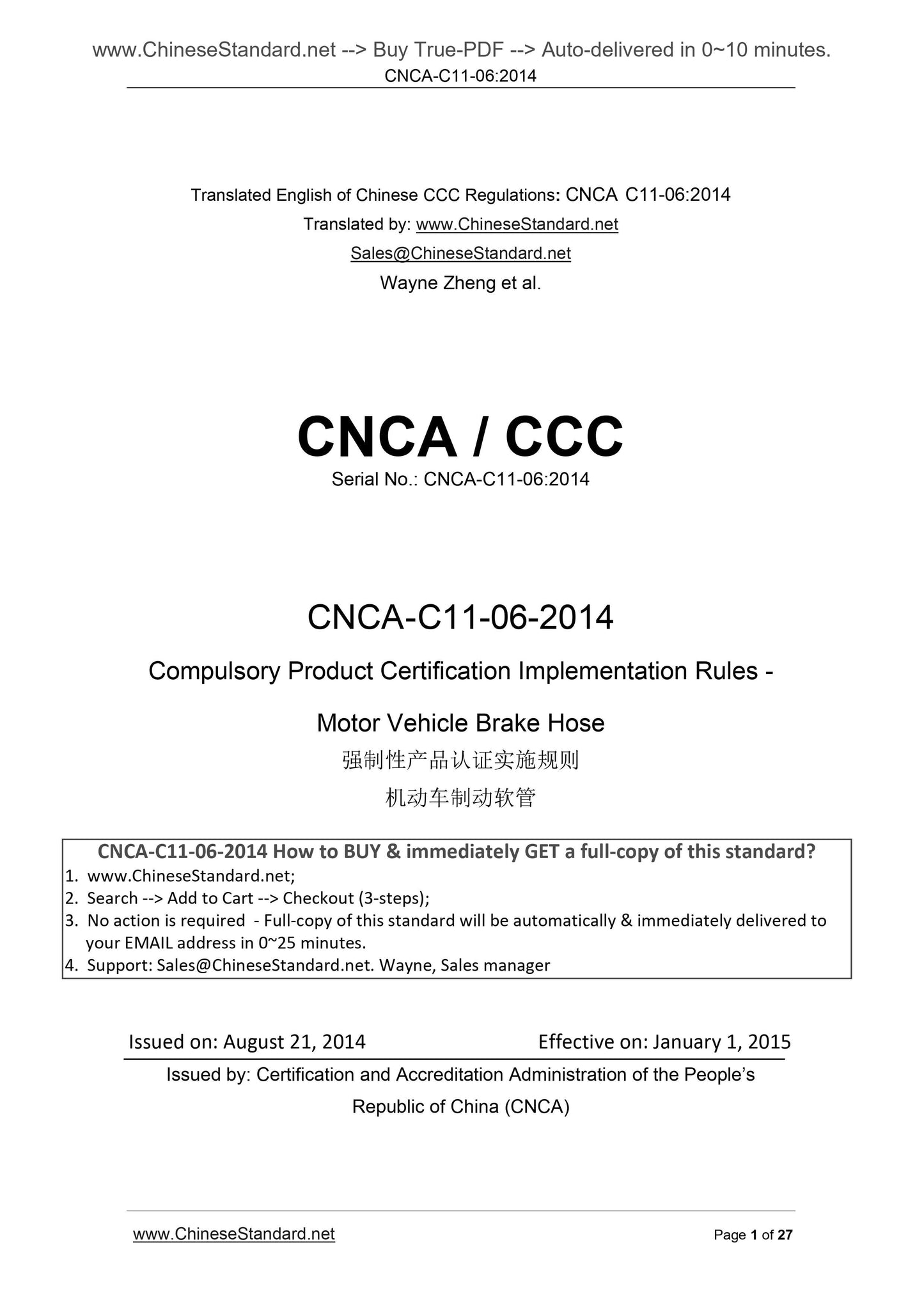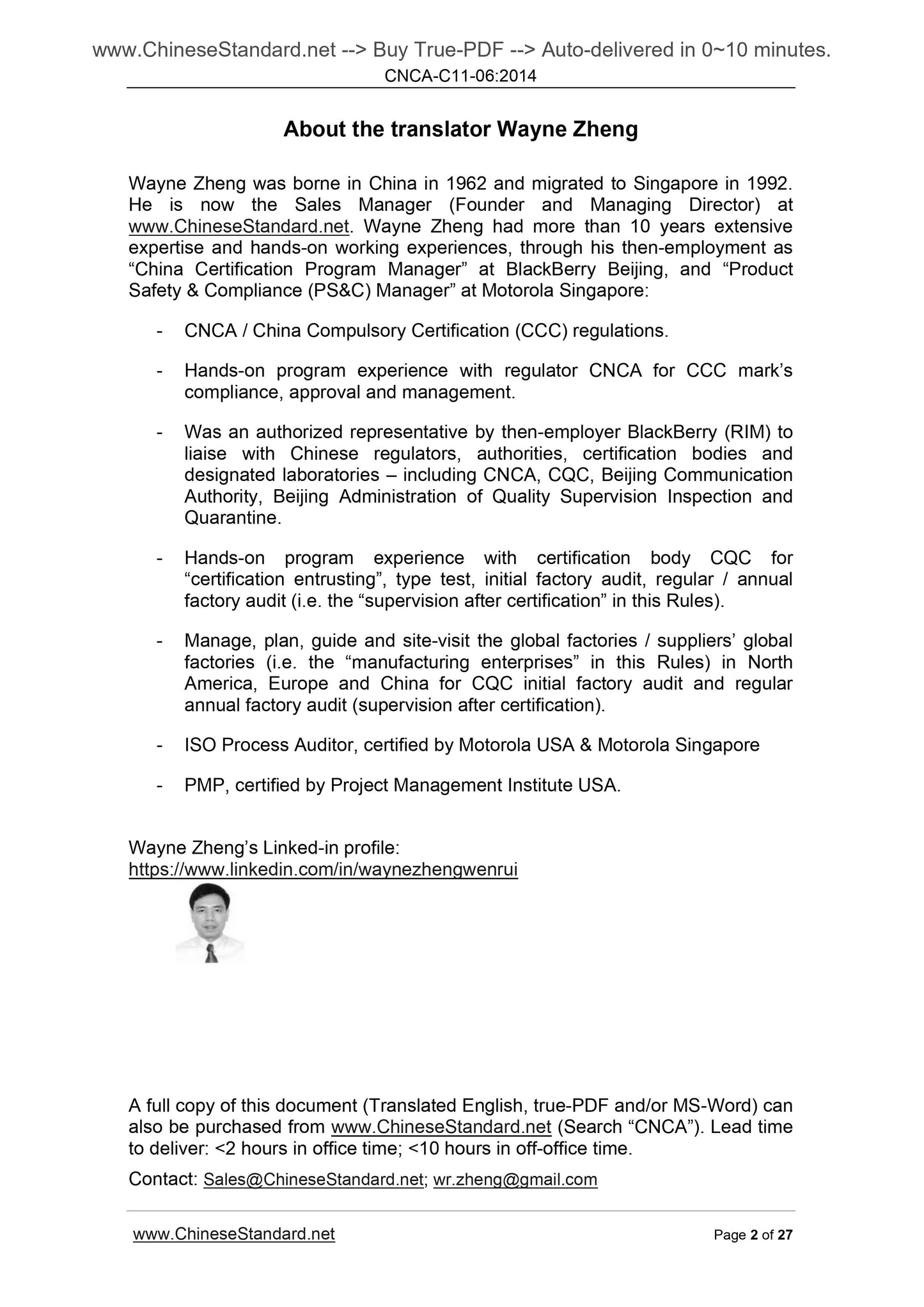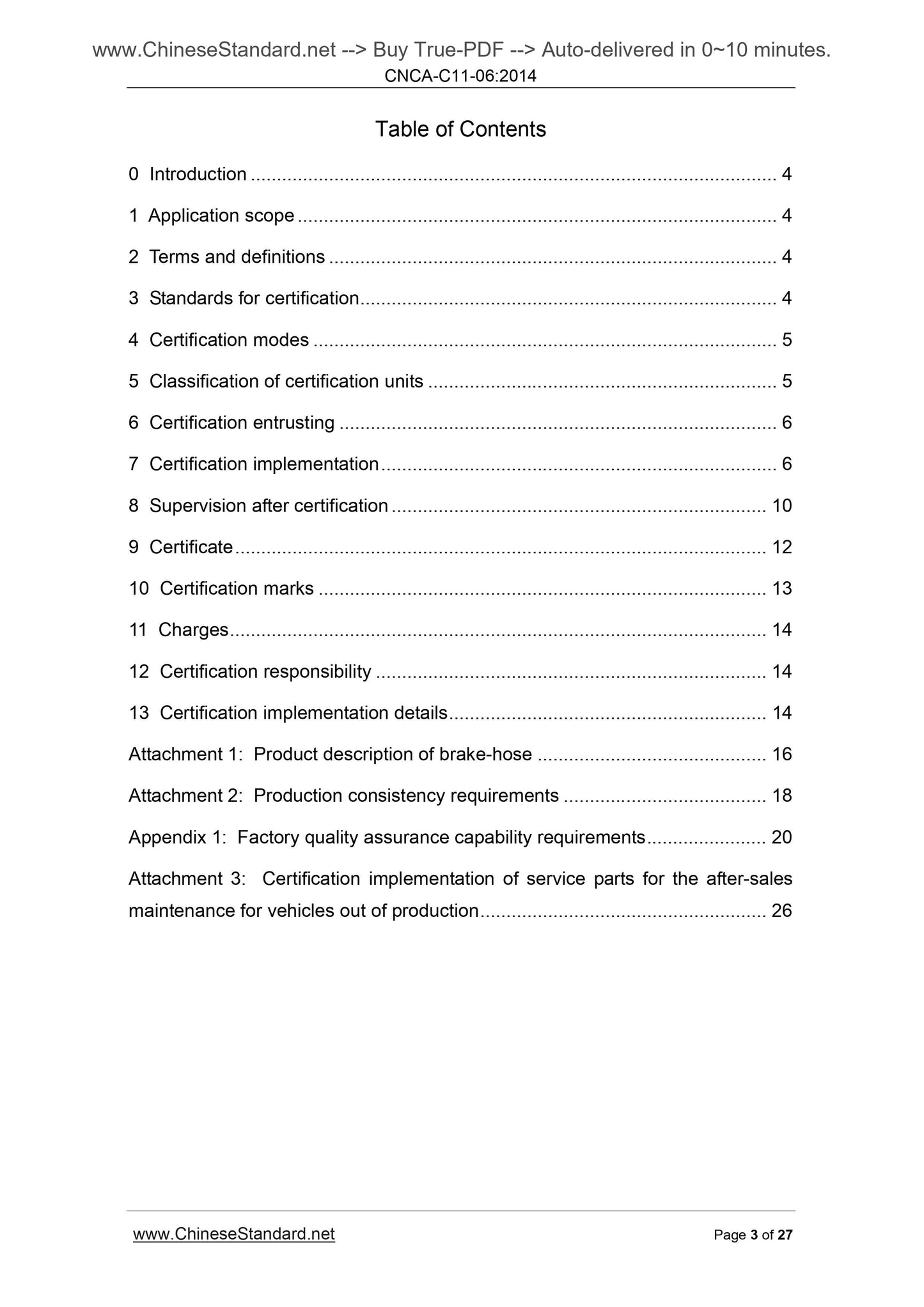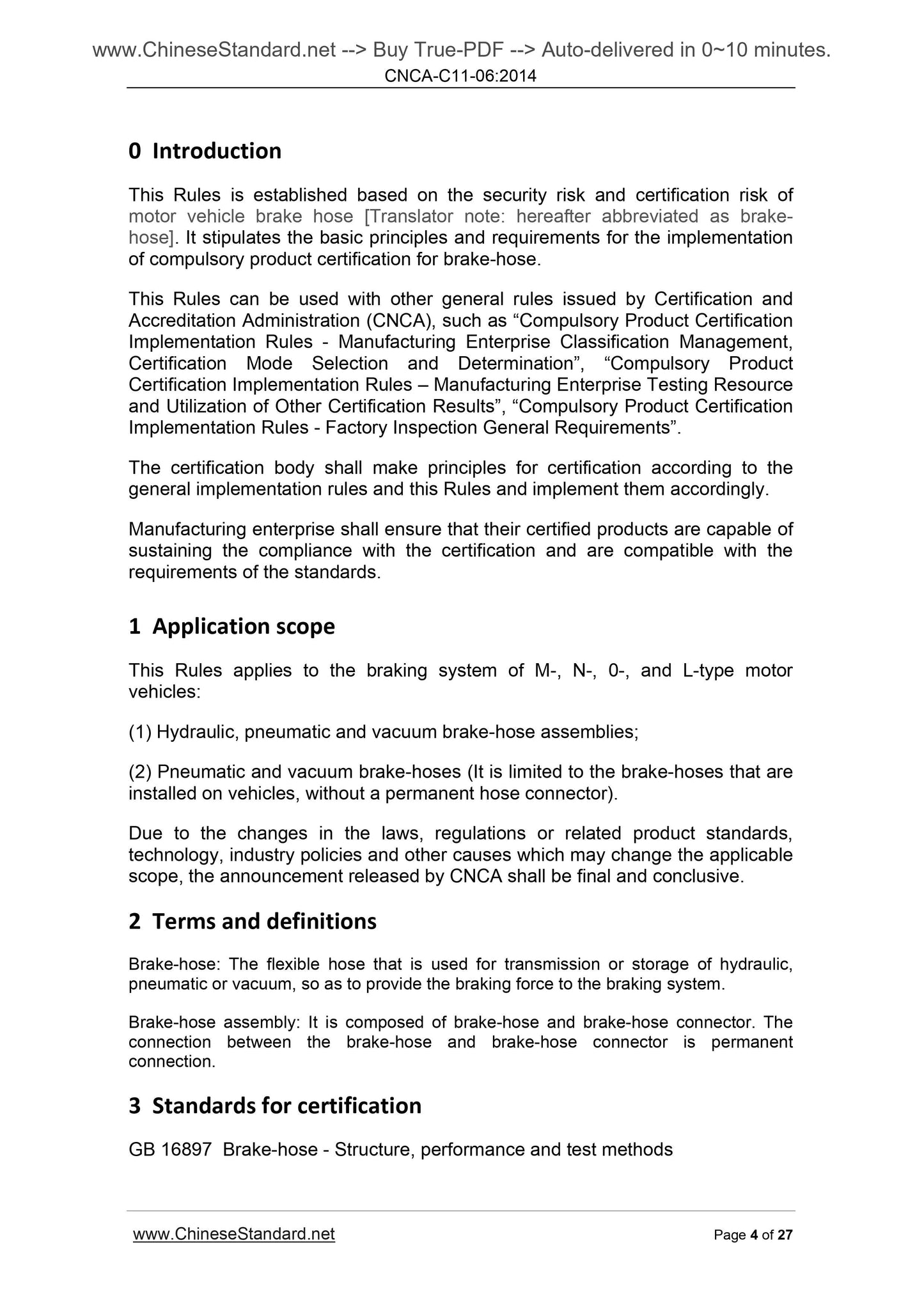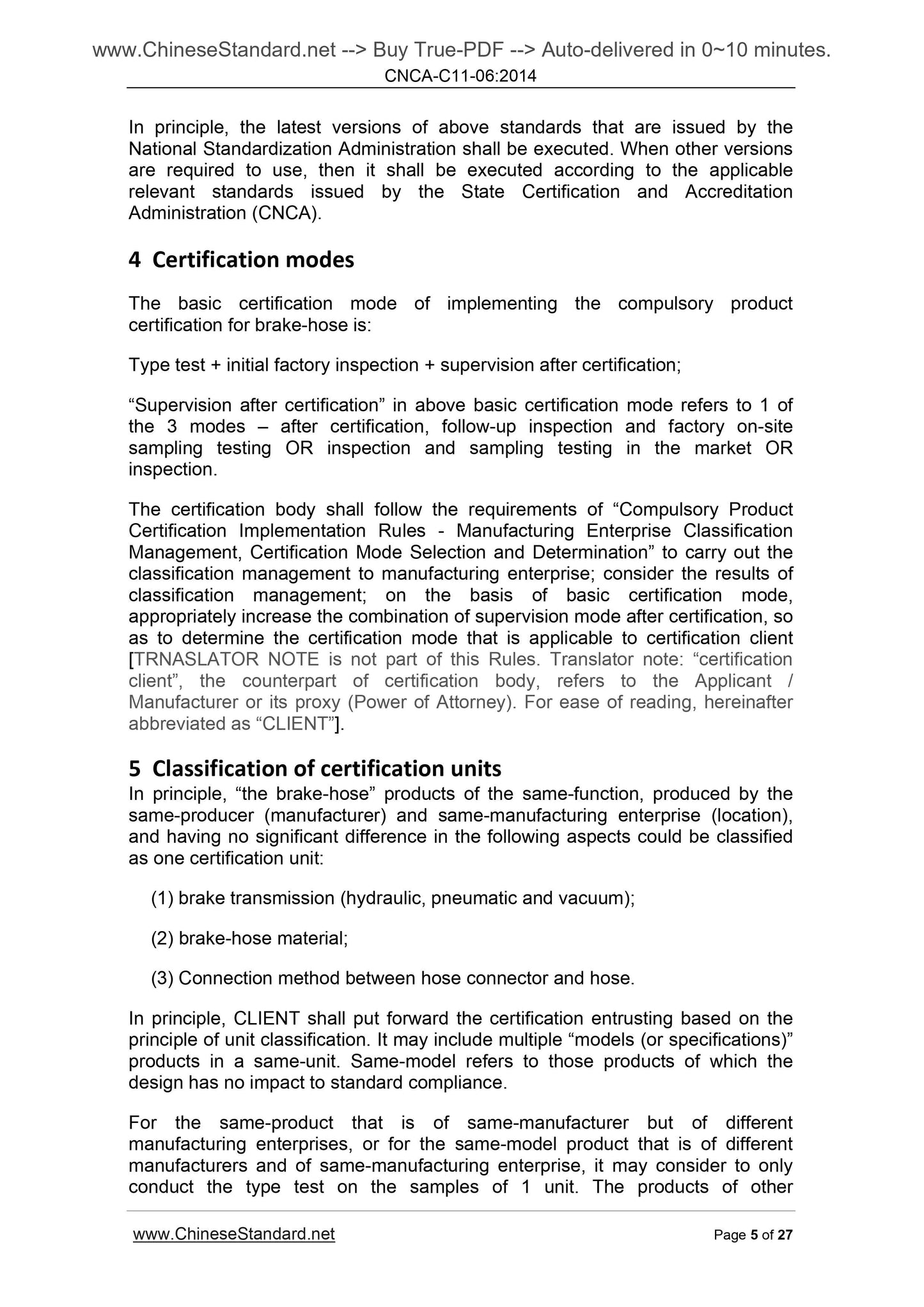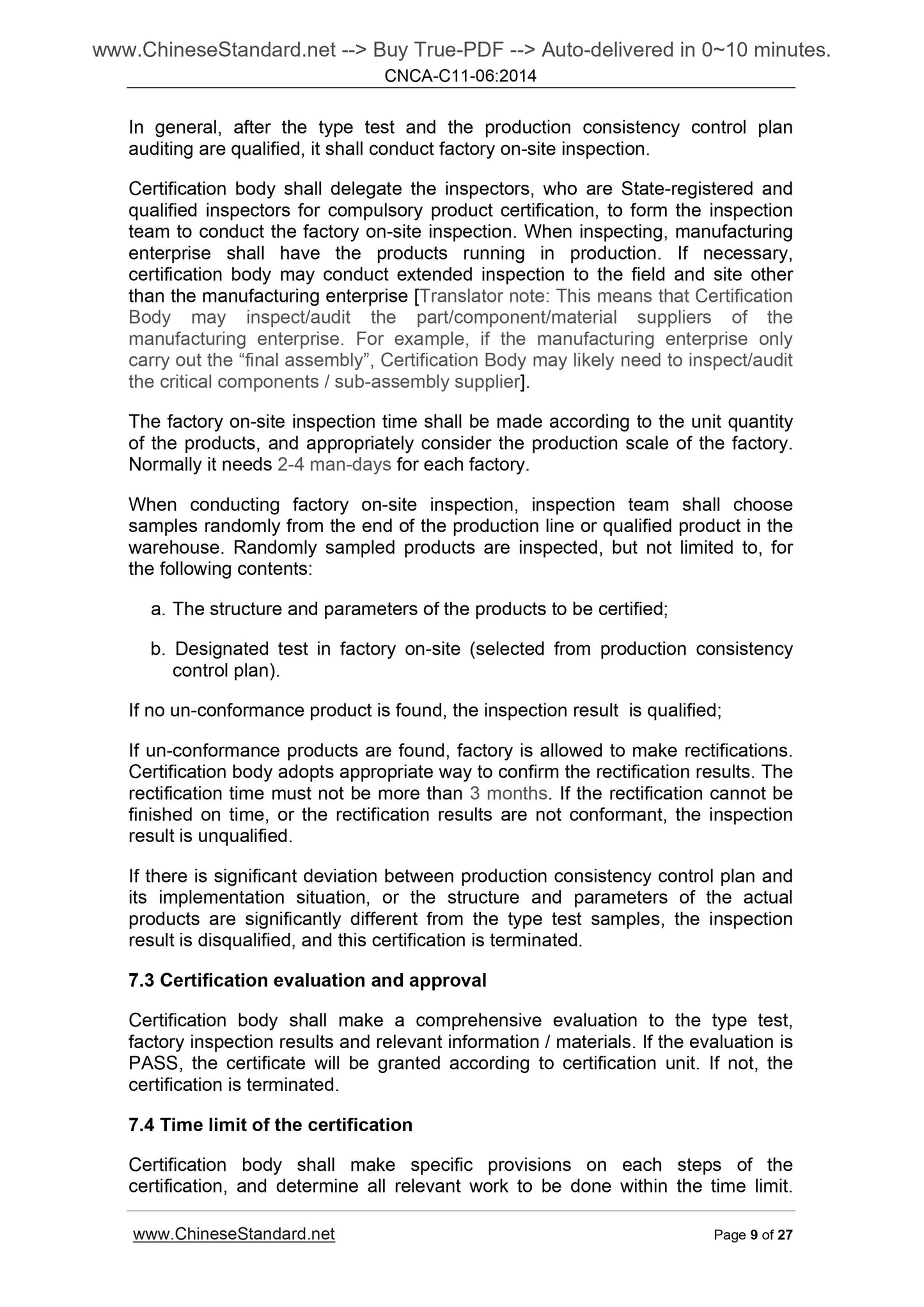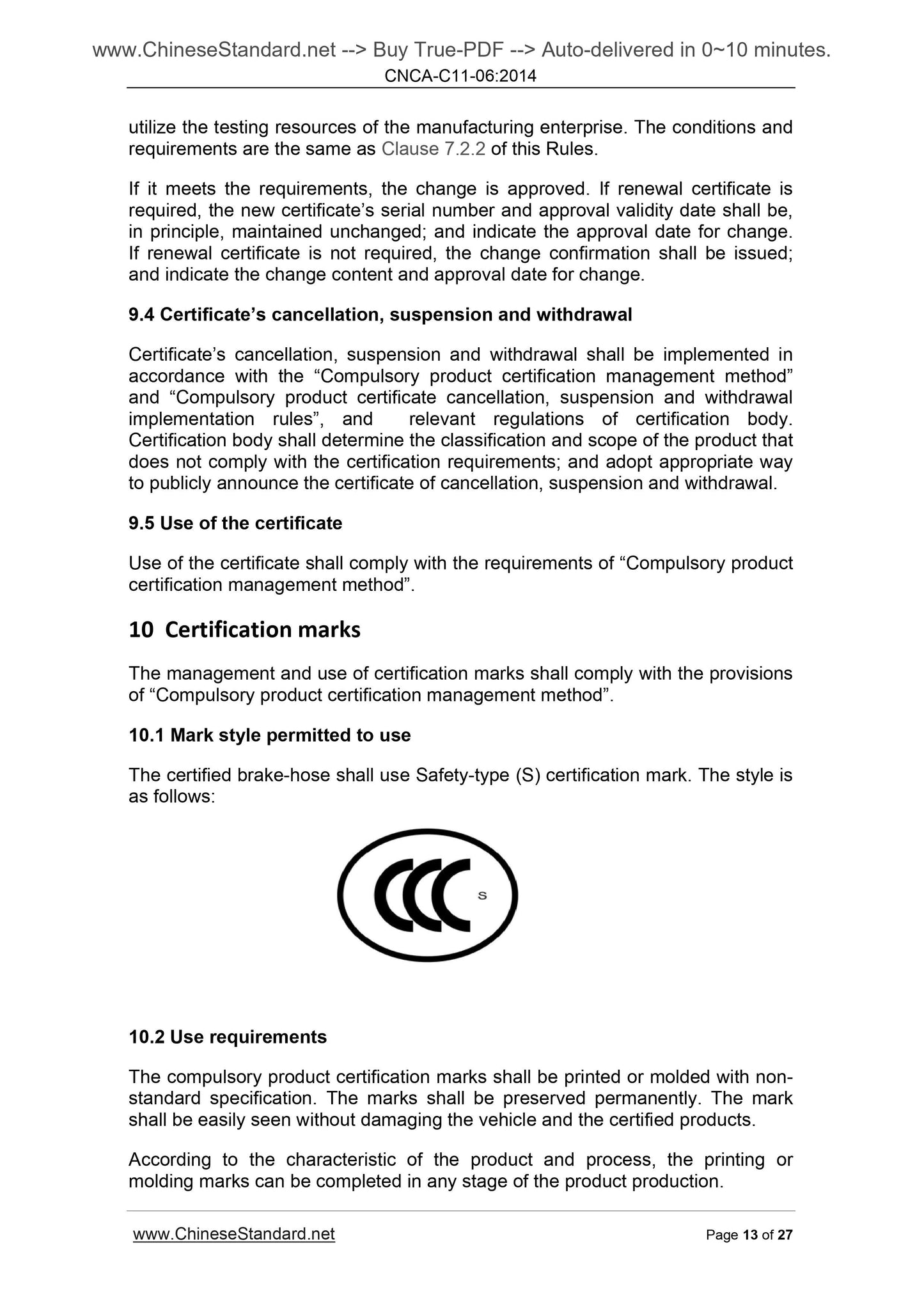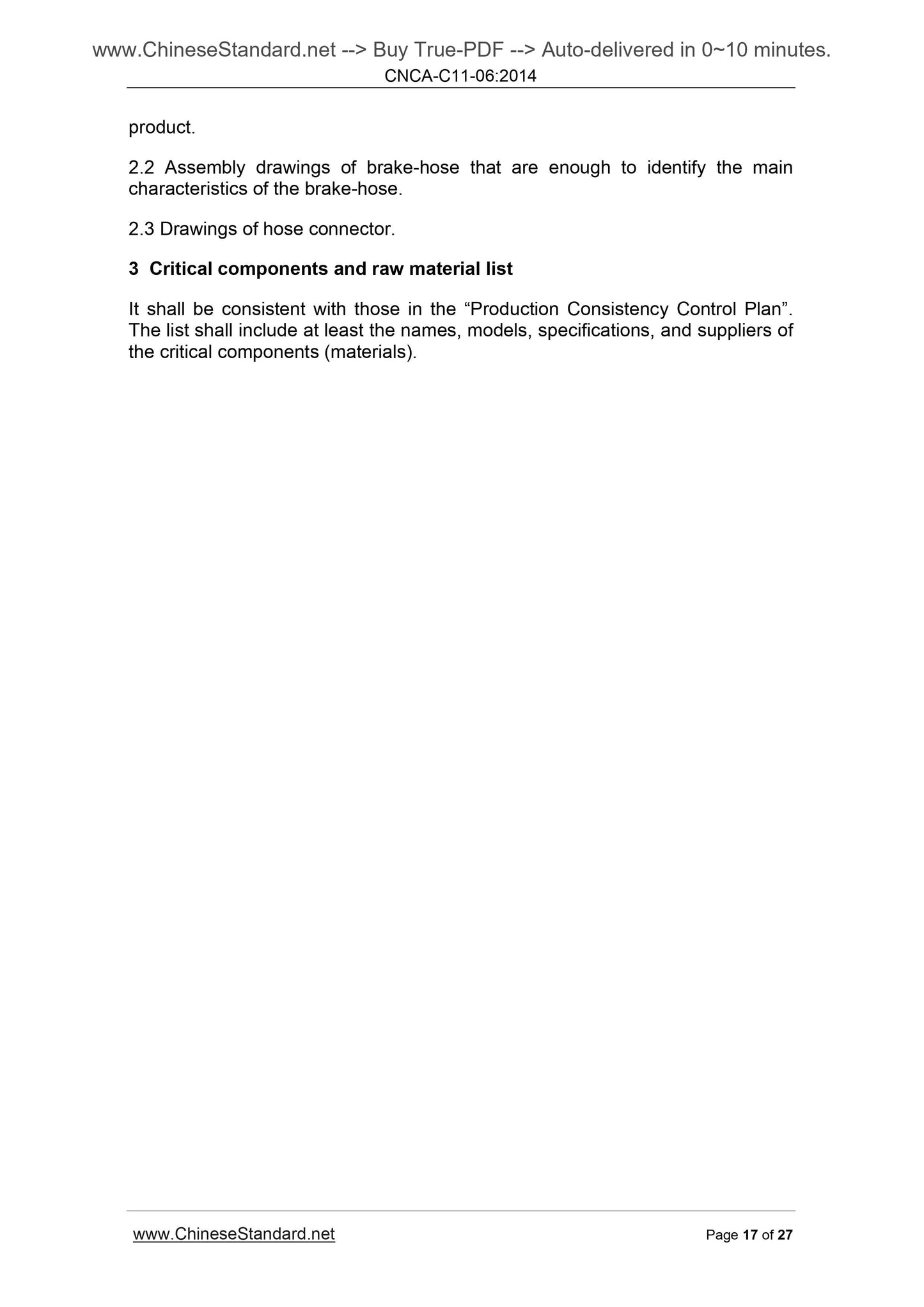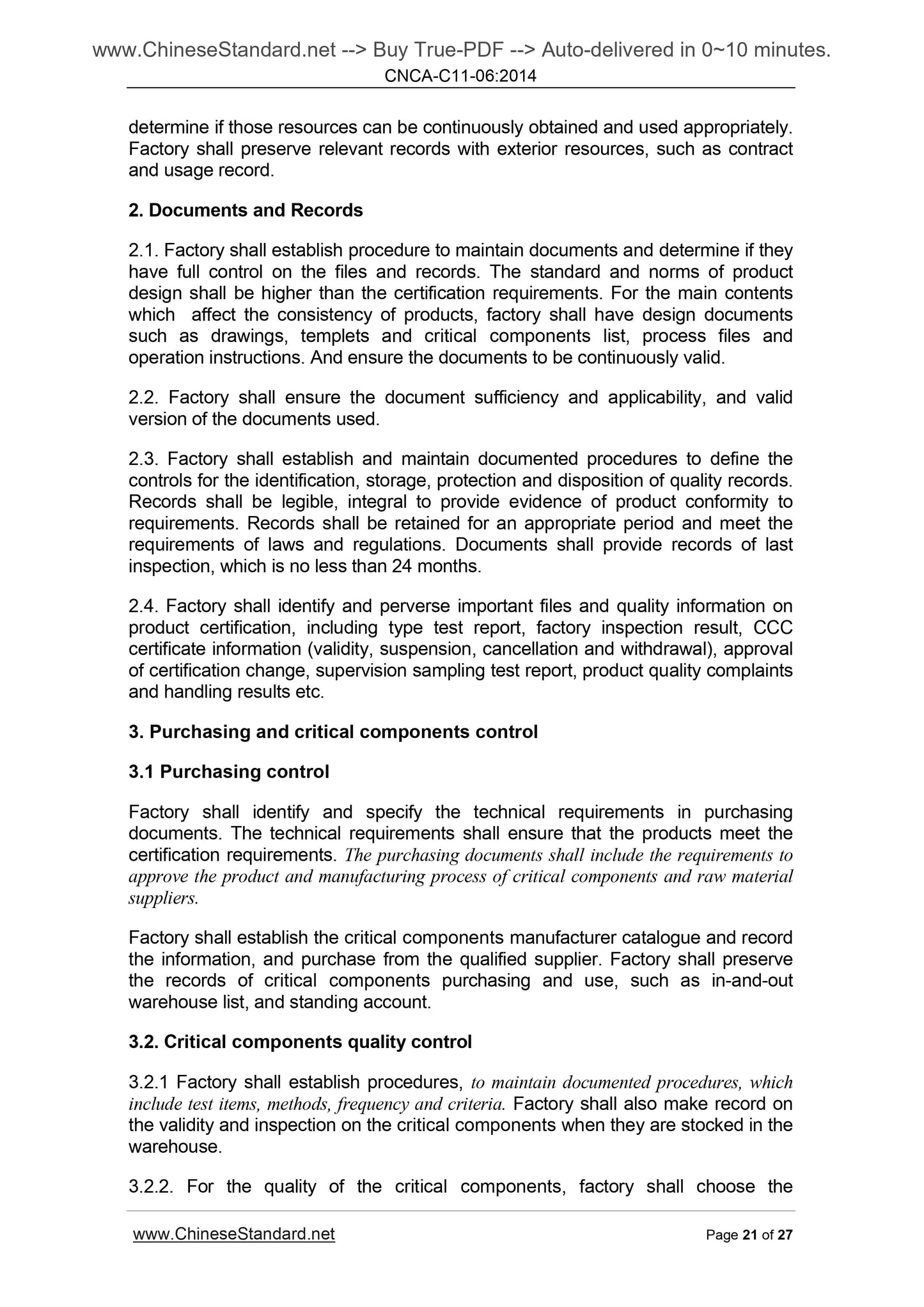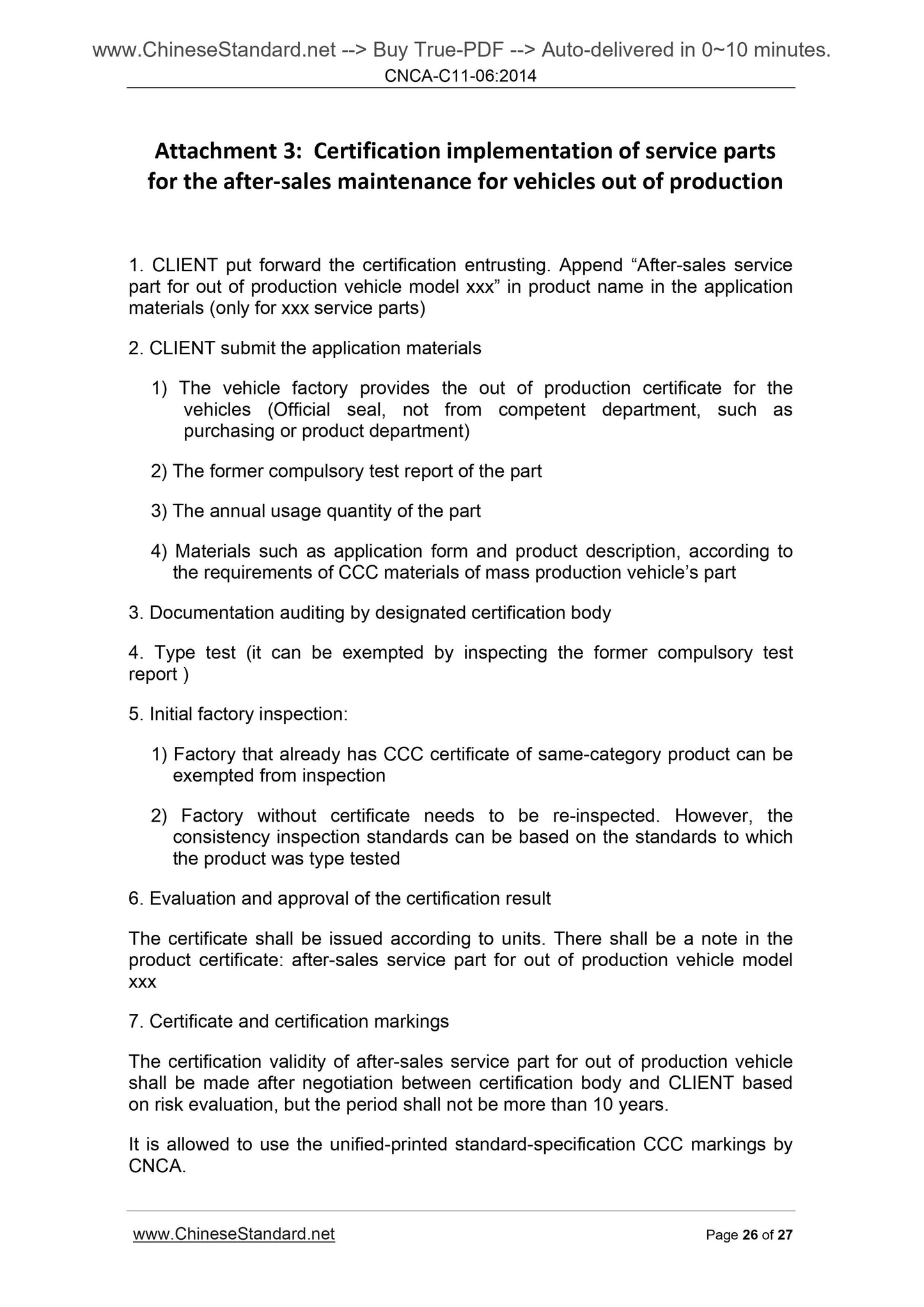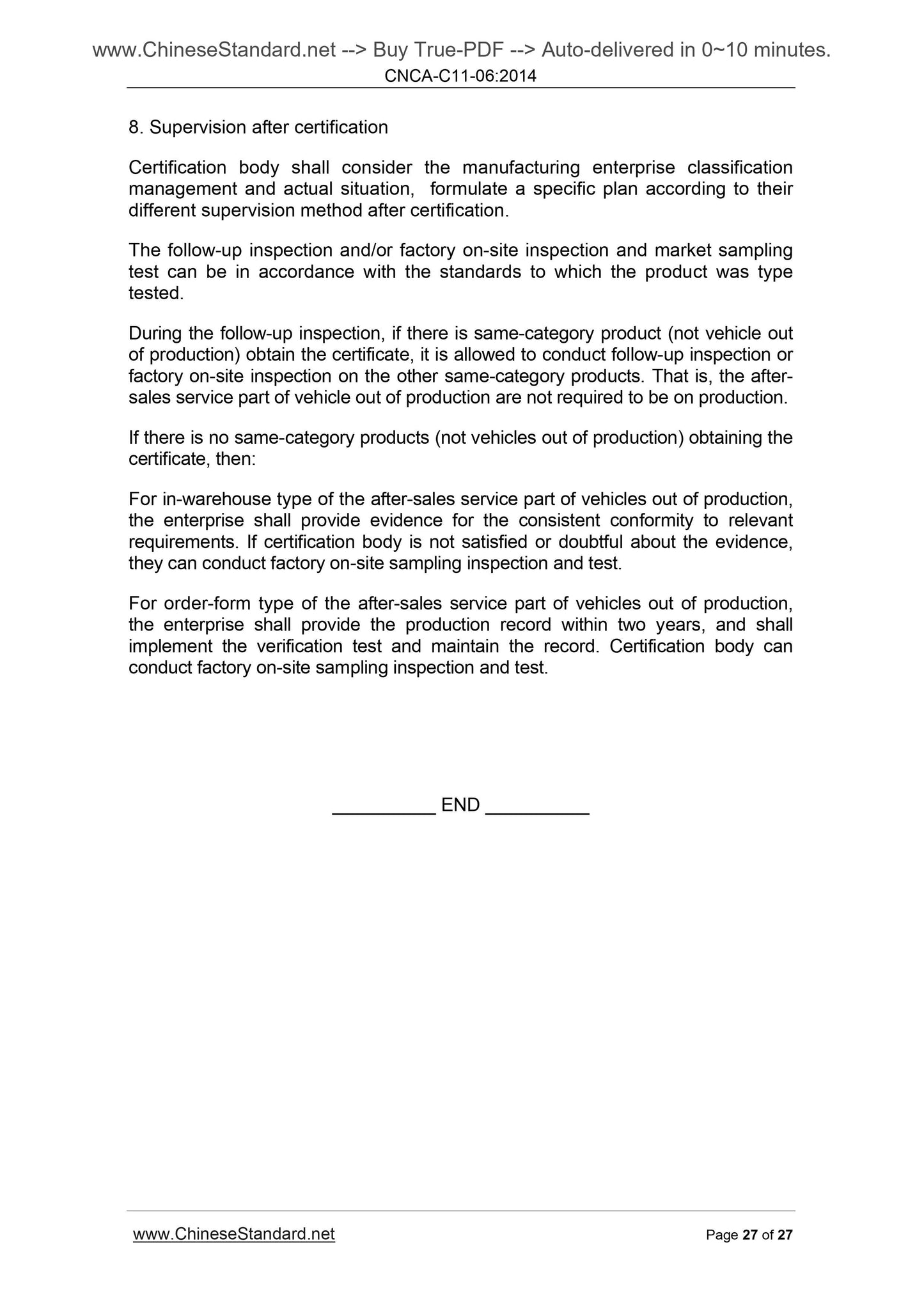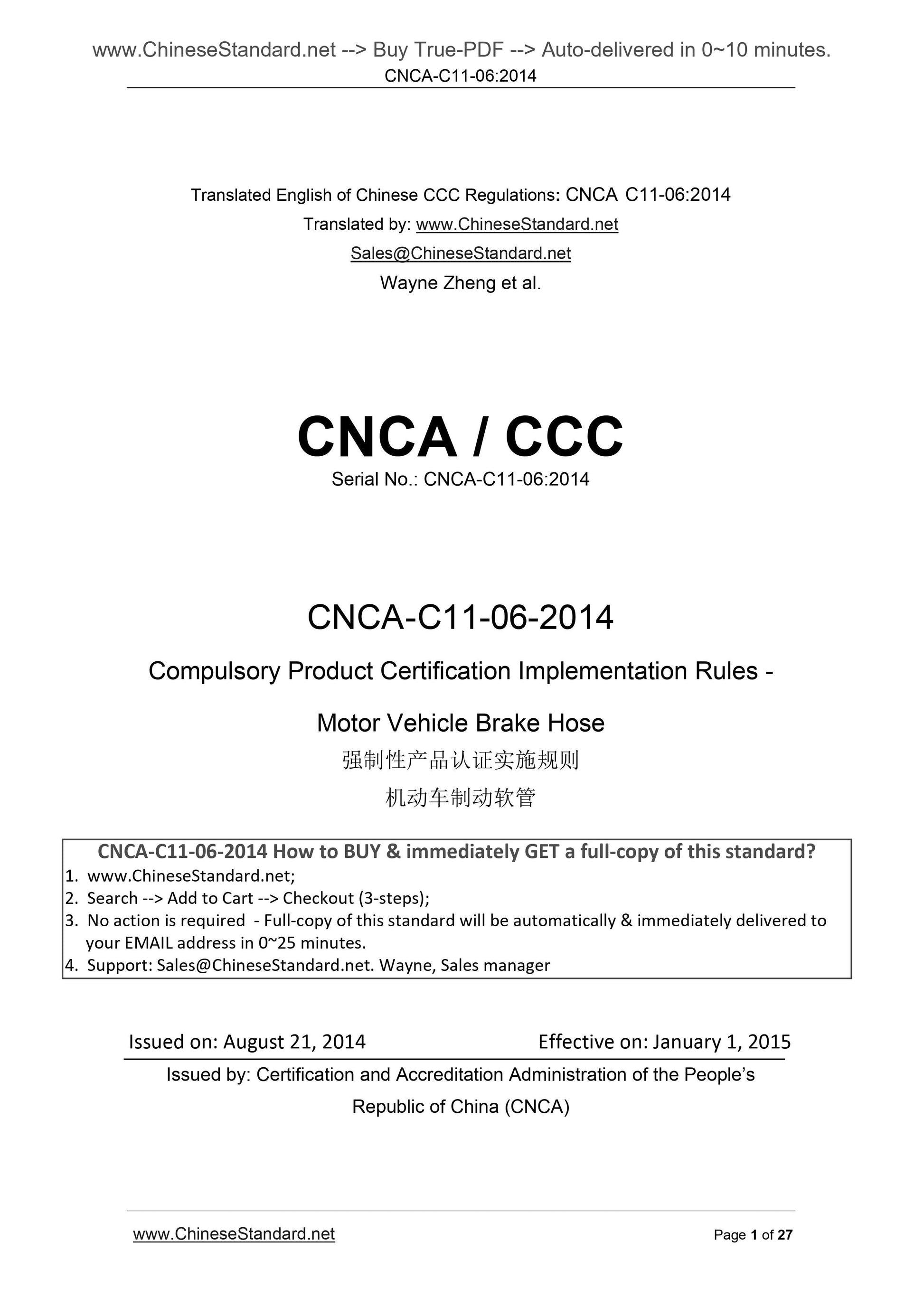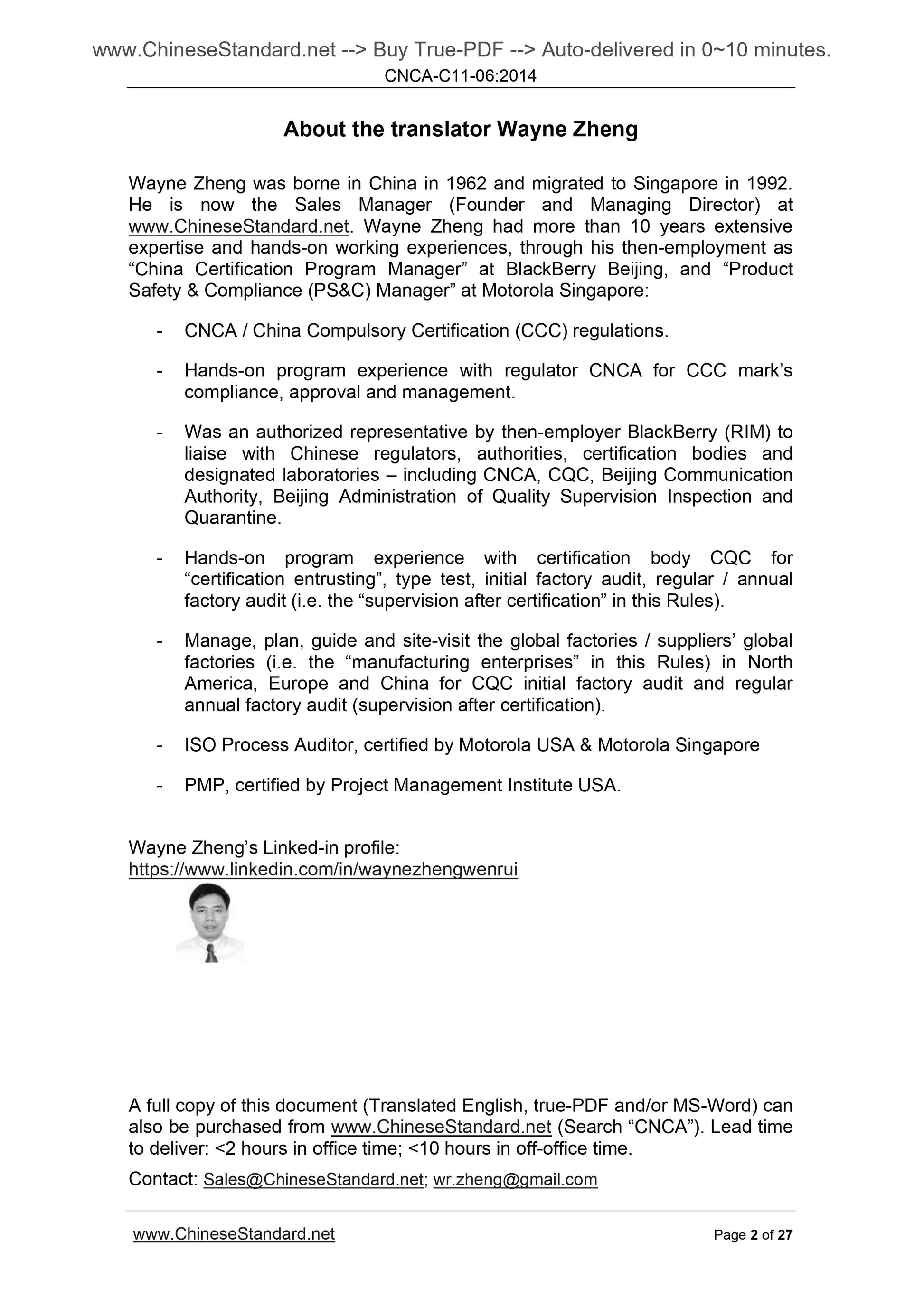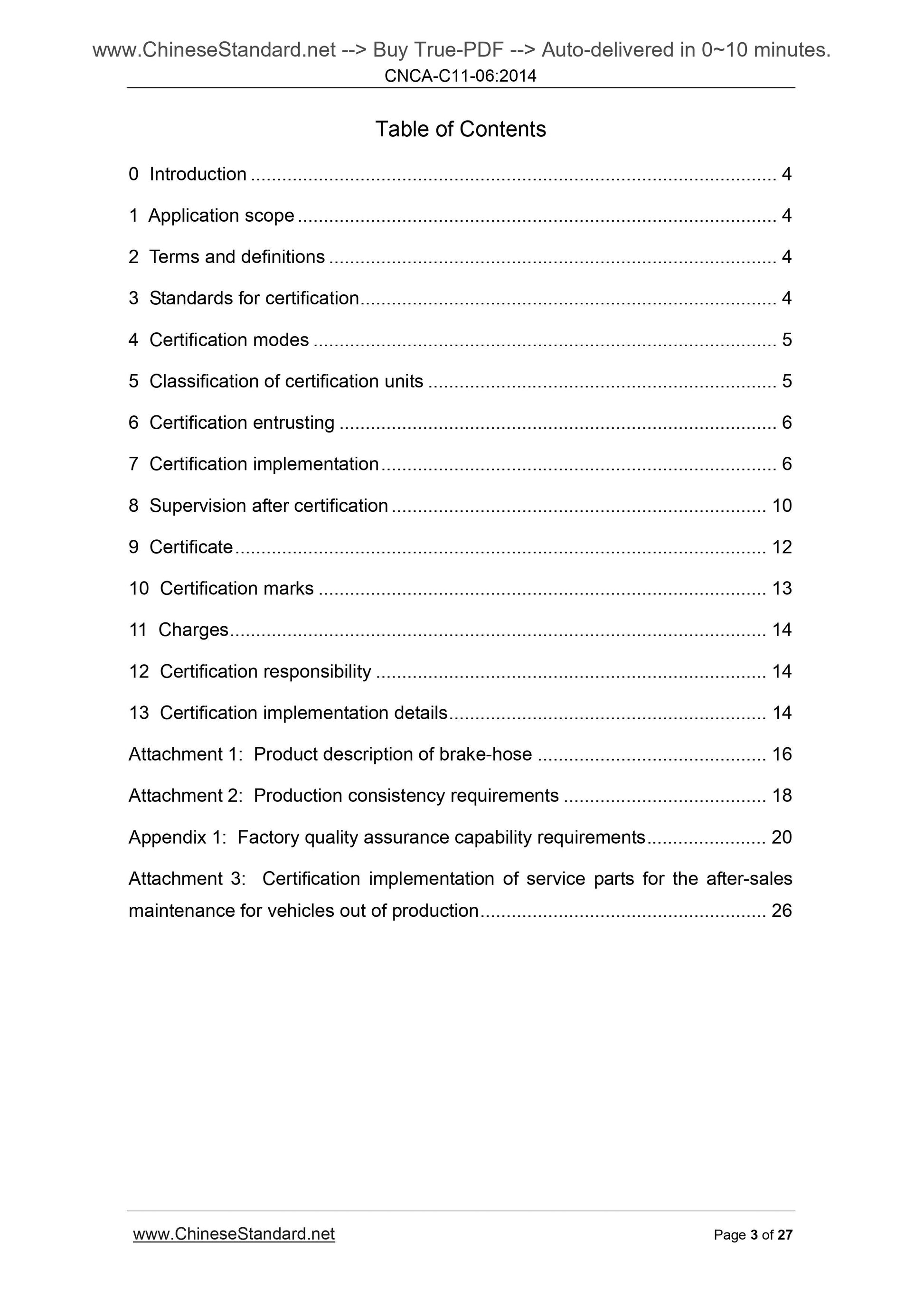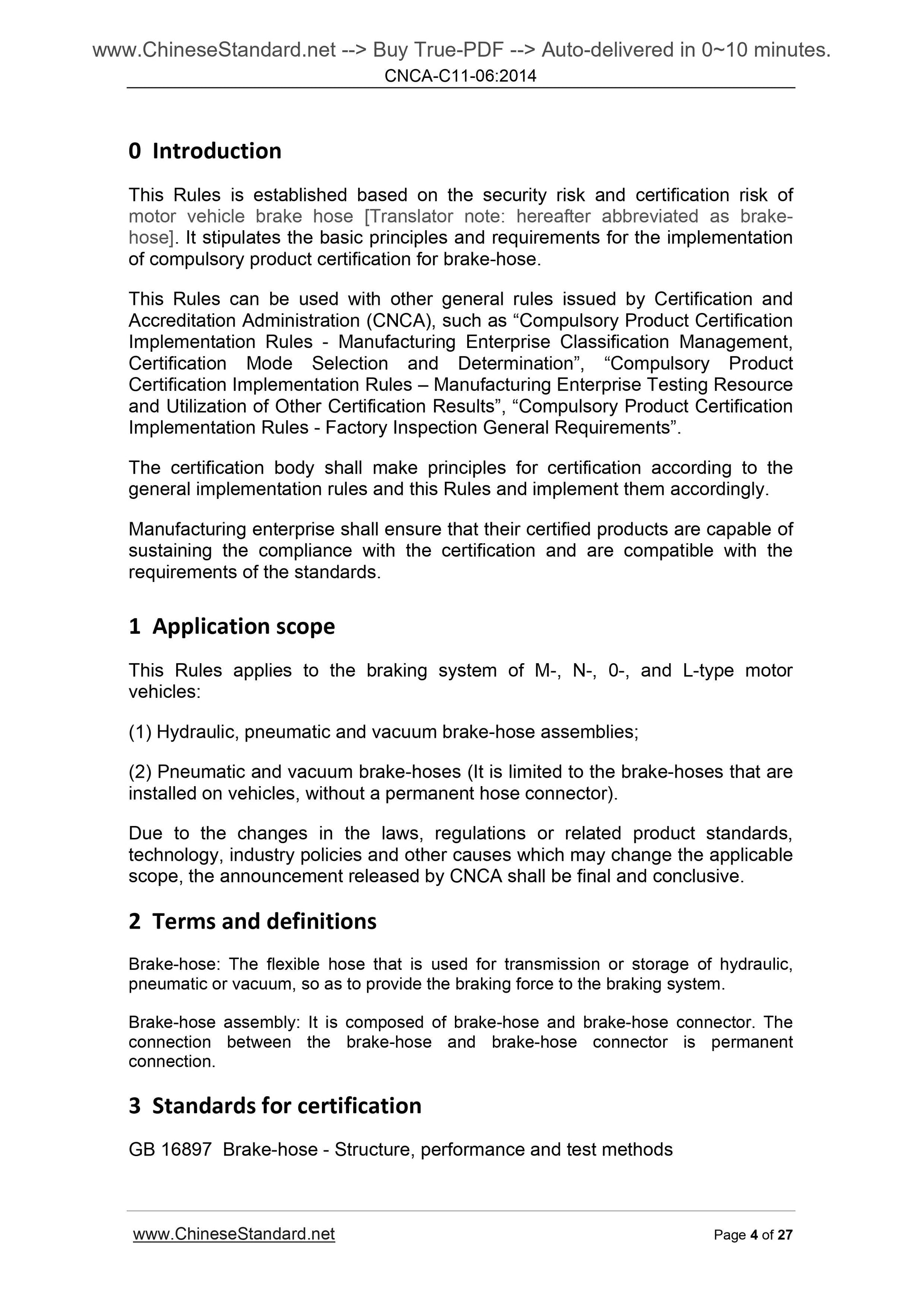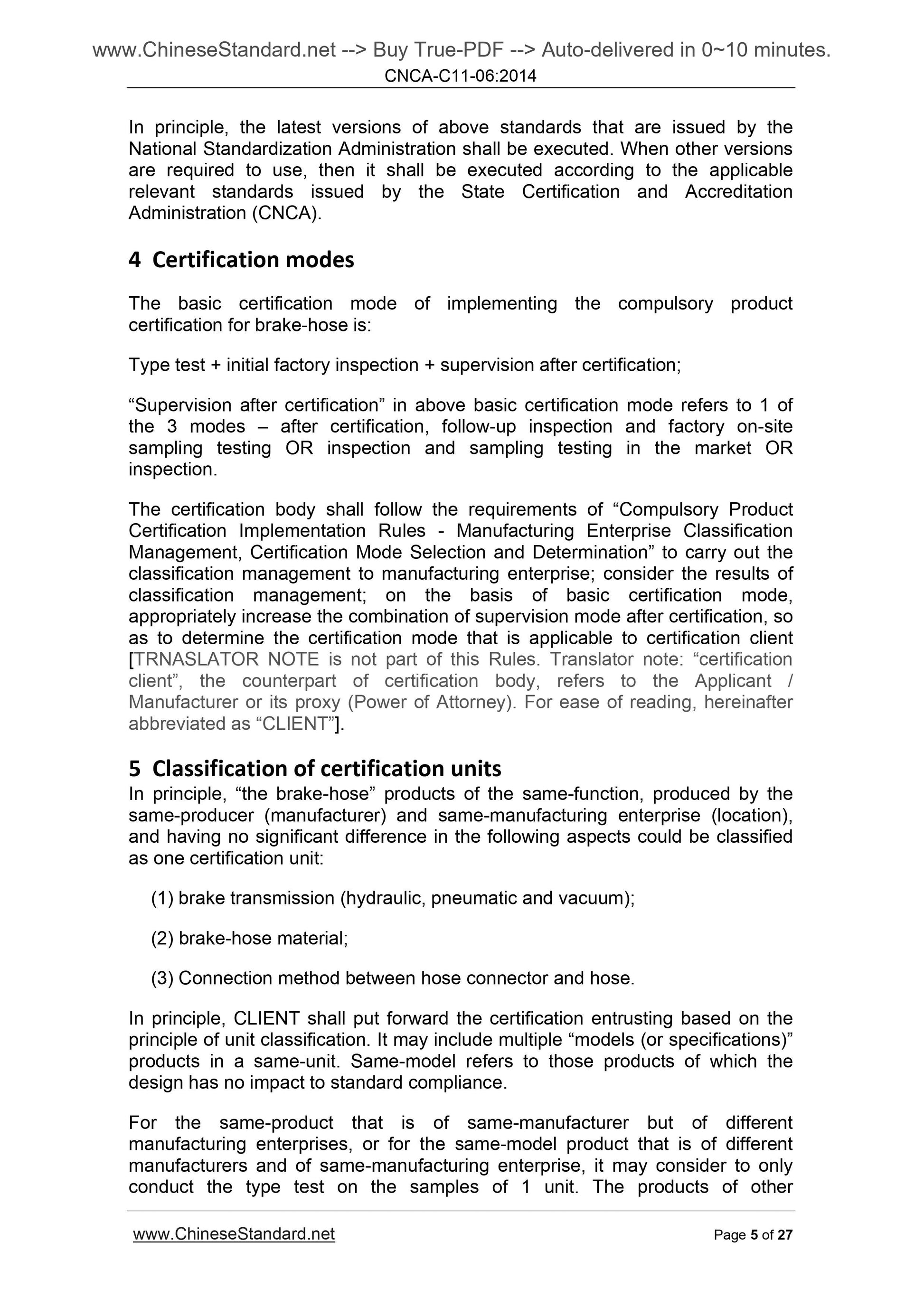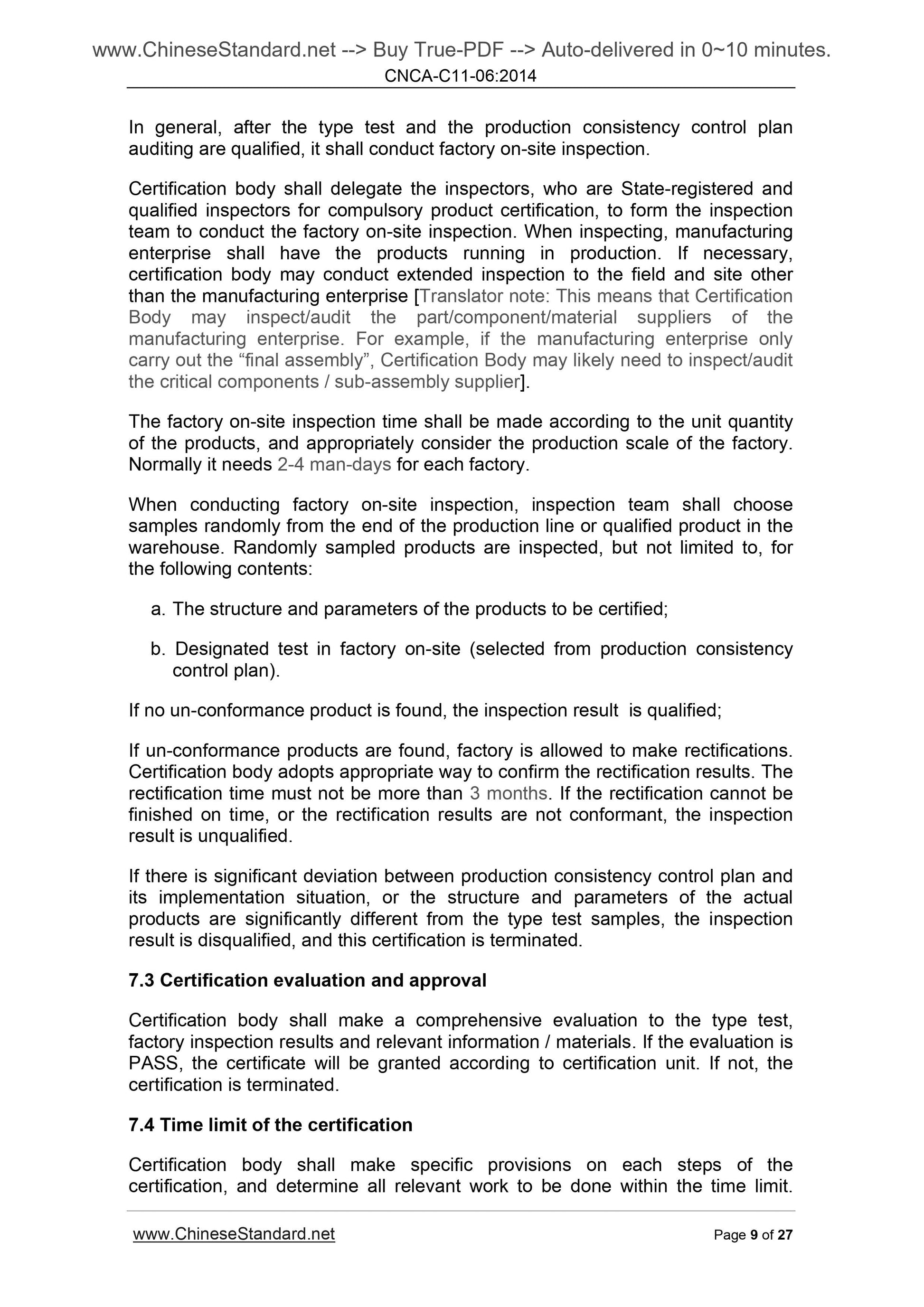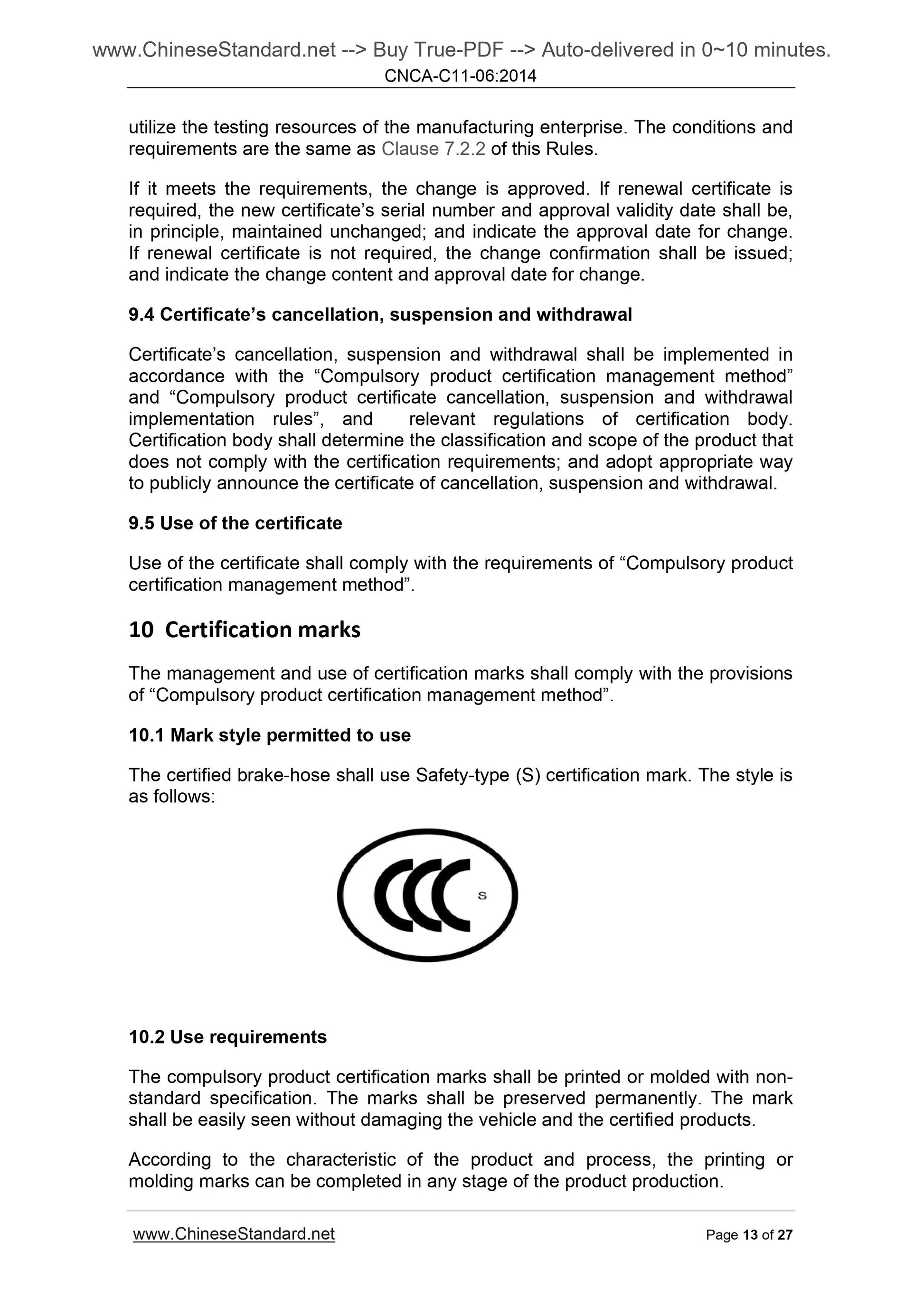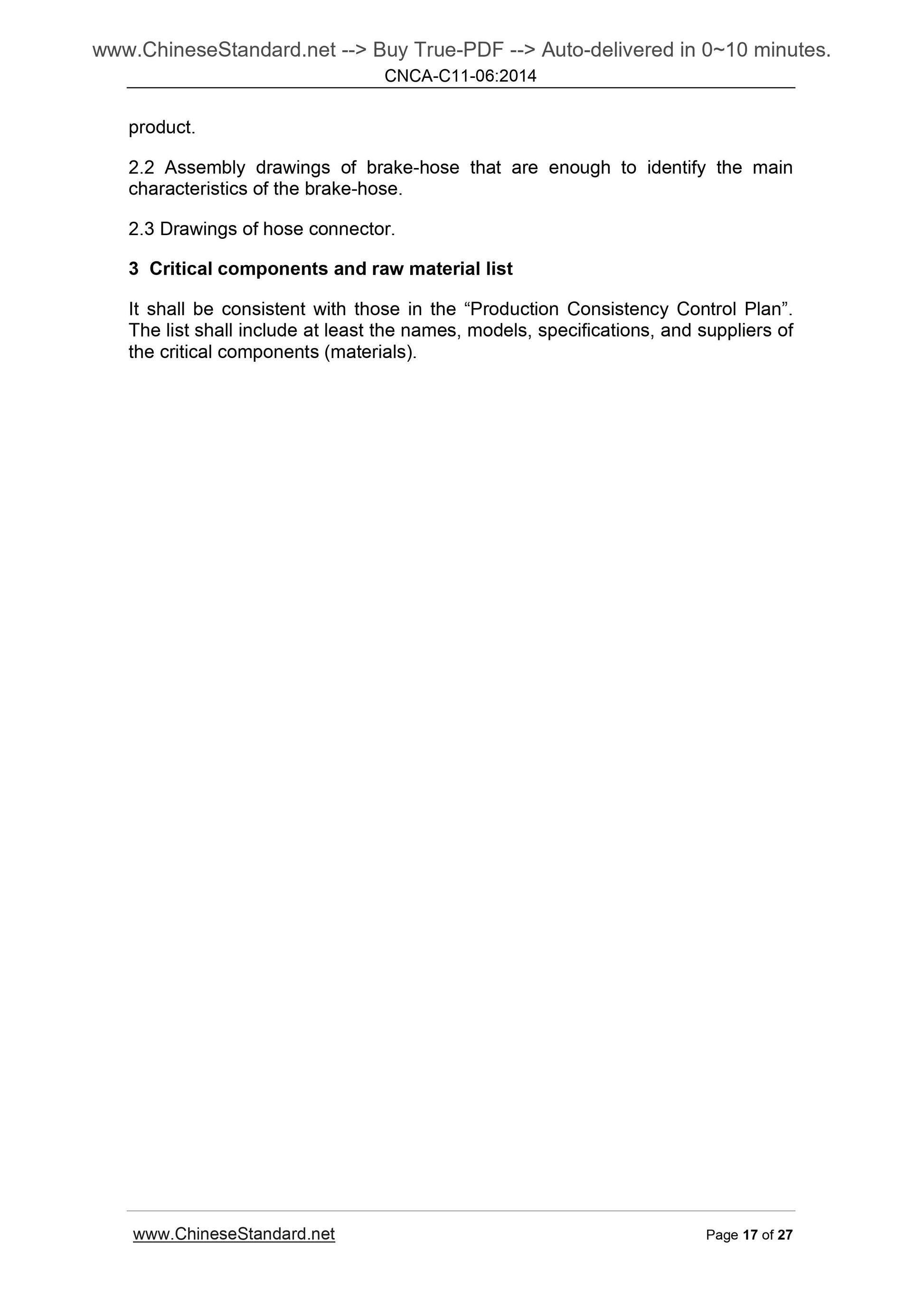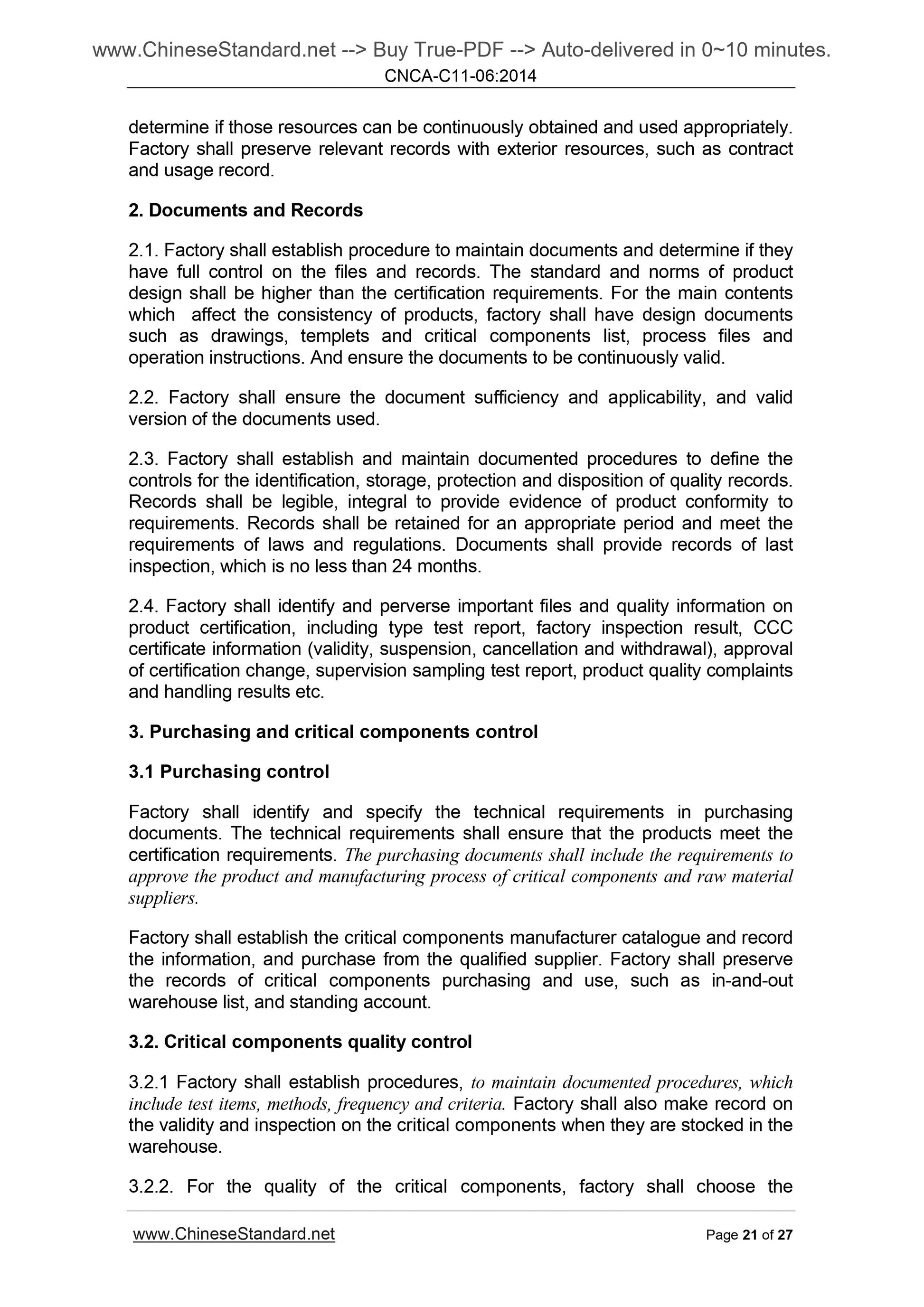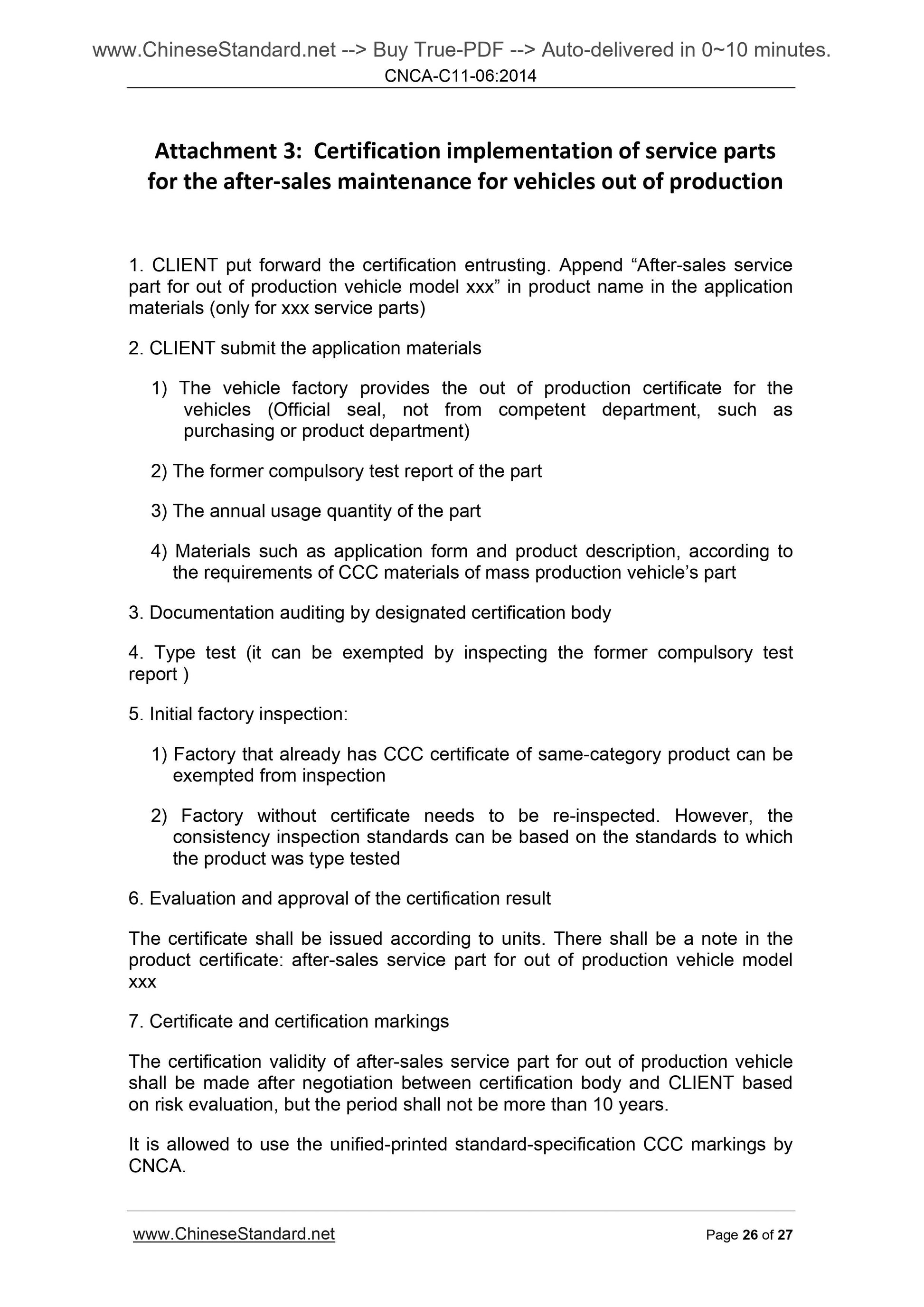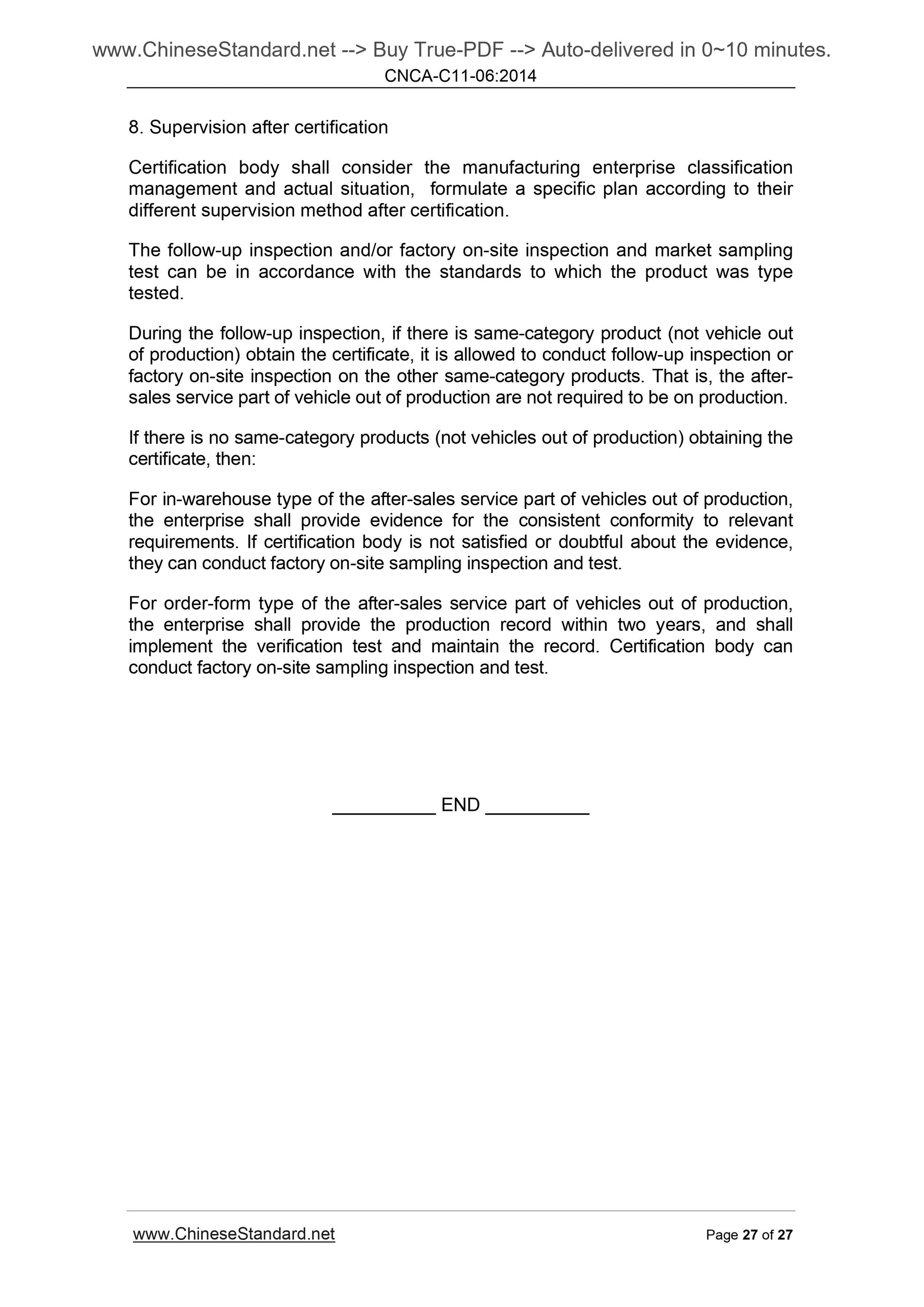1
/
의
11
PayPal, credit cards. Download editable-PDF and invoice in 1 second!
CNCA C11-06-2014 English PDF (CNCAC11-06-2014)
CNCA C11-06-2014 English PDF (CNCAC11-06-2014)
정가
$155.00 USD
정가
할인가
$155.00 USD
단가
/
단위
배송료는 결제 시 계산됩니다.
픽업 사용 가능 여부를 로드할 수 없습니다.
Delivery: 3 seconds. Download true-PDF + Invoice.
Get QUOTATION in 1-minute: Click CNCA C11-06-2014
Historical versions: CNCA C11-06-2014
Preview True-PDF (Reload/Scroll if blank)
CNCA C11-06-2014: China Compulsory Certification Implementation Rules - Motor vehicle brake hose
CNCA-C11-06.2014
CNCA / CCC
Serial No.. CNCA-C11-06.2014
CNCA-C11-06-2014
Compulsory Product Certification Implementation Rules -
Motor Vehicle Brake Hose
Issued on. August 21, 2014 Effective on. January 1, 2015
Issued by. Certification and Accreditation Administration of the People’s
Republic of China (CNCA)
He is now the Sales Manager (Founder and Managing Director) at
expertise and hands-on working experiences, through his then-employment as
“China Certification Program Manager” at BlackBerry Beijing, and “Product
Safety and Compliance (PS and C) Manager” at Motorola Singapore.
- CNCA / China Compulsory Certification (CCC) regulations.
- Hands-on program experience with regulator CNCA for CCC mark’s
compliance, approval and management.
- Was an authorized representative by then-employer BlackBerry (RIM) to
liaise with Chinese regulators, authorities, certification bodies and
designated laboratories – including CNCA, CQC, Beijing Communication
Authority, Beijing Administration of Quality Supervision Inspection and
Quarantine.
- Hands-on program experience with certification body CQC for
“certification entrusting”, type test, initial factory audit, regular / annual
factory audit (i.e. the “supervision after certification” in this Rules).
- Manage, plan, guide and site-visit the global factories / suppliers’ global
factories (i.e. the “manufacturing enterprises” in this Rules) in North
America, Europe and China for CQC initial factory audit and regular
annual factory audit (supervision after certification).
- ISO Process Auditor, certified by Motorola USA and Motorola Singapore
- PMP, certified by Project Management Institute USA.
to deliver. < 2 hours in office time; < 10 hours in off-office time.
Table of Contents
0 Introduction ... 4
1 Application scope ... 4
2 Terms and definitions ... 4
3 Standards for certification ... 4
4 Certification modes ... 5
5 Classification of certification units ... 5
6 Certification entrusting ... 6
7 Certification implementation ... 6
8 Supervision after certification ... 10
9 Certificate ... 12
10 Certification marks ... 13
11 Charges ... 14
12 Certification responsibility ... 14
13 Certification implementation details ... 14
Attachment 1. Product description of brake-hose ... 16
Attachment 2. Production consistency requirements ... 18
Appendix 1. Factory quality assurance capability requirements ... 20
Attachment 3. Certification implementation of service parts for the after-sales
maintenance for vehicles out of production ... 26
0 Introduction
This Rules is established based on the security risk and certification risk of
motor vehicle brake hose [Translator note. hereafter abbreviated as brake-
hose]. It stipulates the basic principles and requirements for the implementation
of compulsory product certification for brake-hose.
This Rules can be used with other general rules issued by Certification and
Accreditation Administration (CNCA), such as “Compulsory Product Certification
Implementation Rules - Manufacturing Enterprise Classification Management,
Certification Mode Selection and Determination”, “Compulsory Product
Certification Implementation Rules – Manufacturing Enterprise Testing Resource
and Utilization of Other Certification Results”, “Compulsory Product Certification
Implementation Rules - Factory Inspection General Requirements”.
The certification body shall make principles for certification according to the
general implementation rules and this Rules and implement them accordingly.
Manufacturing enterprise shall ensure that their certified products are capable of
sustaining the compliance with the certification and are compatible with the
requirements of the standards.
1 Application scope
This Rules applies to the braking system of M-, N-, 0-, and L-type motor
vehicles.
(1) Hydraulic, pneumatic and vacuum brake-hose assemblies;
(2) Pneumatic and vacuum brake-hoses (It is limited to the brake-hoses that are
installed on vehicles, without a permanent hose connector).
Due to the changes in the laws, regulations or related product standards,
technology, industry policies and other causes which may change the applicable
scope, the announcement released by CNCA shall be final and conclusive.
2 Terms and definitions
Brake-hose. The flexible hose that is used for transmission or storage of hydraulic,
pneumatic or vacuum, so as to provide the braking force to the braking system.
Brake-hose assembly. It is composed of brake-hose and brake-hose connector. The
connection between the brake-hose and brake-hose connector is permanent
connection.
3 Standards for certification
GB 16897 Brake-hose - Structure, performance and test methods
In principle, the latest versions of above standards that are issued by the
National Standardization Administration shall be executed. When other versions
are required to use, then it shall be executed according to the applicable
relevant standards issued by the State Certification and Accreditation
Administration (CNCA).
4 Certification modes
The basic certification mode of implementing the compulsory product
certification for brake-hose is.
Type test + initial factory inspection + supervision after certification;
“Supervision after certification” in above basic certification mode refers to 1 of
the 3 modes – after certification, follow-up inspection and factory on-site
sampling testing OR inspection and sampling testing in the market OR
inspection.
The certification body shall follow the requirements of “Compulsory Product
Certification Implementation Rules - Manufacturing Enterprise Classification
Management, Certification Mode Selection and Determination” to carry out the
classification management to manufacturing enterprise; consider the results of
classification management; on the basis of basic certification mode,
appropriately increase the combination of supervision mode after certification, so
as to determine the certification mode that is applicable to certification client
[TRNASLATOR NOTE is not part of this Rules. Translator note. “certification
client”, the counterpart of certification body, refers to the Applicant /
Manufacturer or its proxy (Power of Attorney). For ease of reading, hereinafter
abbreviated as “CLIENT”].
5 Classification of certification units
In principle, “the brake-hose” products of the same-function, produced by the
same-producer (manufacturer) and same-manufacturing enterprise (location),
and having no significant difference in the following aspects could be classified
as one certification unit.
(1) brake transmission (hydraulic, pneumatic and vacuum);
(2) brake-hose material;
(3) Connection method between hose connector and hose.
In principle, CLIENT shall put forward the certification entrusting based on the
principle of unit classification. It may include multiple “models (or specifications)”
products in a same-unit. Same-model refers to those products of which the
design has no impact to standard compliance.
For the same-product that is of same-manufacturer but of different
manufacturing enterprises, or for the same-model product that is of different
manufacturers and of same-manufacturing enterprise, it may consider to only
conduct the type test on the samples of 1 unit. The products of other
In general, after the type test and the production consistency control plan
auditing are qualified, it shal...
Get QUOTATION in 1-minute: Click CNCA C11-06-2014
Historical versions: CNCA C11-06-2014
Preview True-PDF (Reload/Scroll if blank)
CNCA C11-06-2014: China Compulsory Certification Implementation Rules - Motor vehicle brake hose
CNCA-C11-06.2014
CNCA / CCC
Serial No.. CNCA-C11-06.2014
CNCA-C11-06-2014
Compulsory Product Certification Implementation Rules -
Motor Vehicle Brake Hose
Issued on. August 21, 2014 Effective on. January 1, 2015
Issued by. Certification and Accreditation Administration of the People’s
Republic of China (CNCA)
He is now the Sales Manager (Founder and Managing Director) at
expertise and hands-on working experiences, through his then-employment as
“China Certification Program Manager” at BlackBerry Beijing, and “Product
Safety and Compliance (PS and C) Manager” at Motorola Singapore.
- CNCA / China Compulsory Certification (CCC) regulations.
- Hands-on program experience with regulator CNCA for CCC mark’s
compliance, approval and management.
- Was an authorized representative by then-employer BlackBerry (RIM) to
liaise with Chinese regulators, authorities, certification bodies and
designated laboratories – including CNCA, CQC, Beijing Communication
Authority, Beijing Administration of Quality Supervision Inspection and
Quarantine.
- Hands-on program experience with certification body CQC for
“certification entrusting”, type test, initial factory audit, regular / annual
factory audit (i.e. the “supervision after certification” in this Rules).
- Manage, plan, guide and site-visit the global factories / suppliers’ global
factories (i.e. the “manufacturing enterprises” in this Rules) in North
America, Europe and China for CQC initial factory audit and regular
annual factory audit (supervision after certification).
- ISO Process Auditor, certified by Motorola USA and Motorola Singapore
- PMP, certified by Project Management Institute USA.
to deliver. < 2 hours in office time; < 10 hours in off-office time.
Table of Contents
0 Introduction ... 4
1 Application scope ... 4
2 Terms and definitions ... 4
3 Standards for certification ... 4
4 Certification modes ... 5
5 Classification of certification units ... 5
6 Certification entrusting ... 6
7 Certification implementation ... 6
8 Supervision after certification ... 10
9 Certificate ... 12
10 Certification marks ... 13
11 Charges ... 14
12 Certification responsibility ... 14
13 Certification implementation details ... 14
Attachment 1. Product description of brake-hose ... 16
Attachment 2. Production consistency requirements ... 18
Appendix 1. Factory quality assurance capability requirements ... 20
Attachment 3. Certification implementation of service parts for the after-sales
maintenance for vehicles out of production ... 26
0 Introduction
This Rules is established based on the security risk and certification risk of
motor vehicle brake hose [Translator note. hereafter abbreviated as brake-
hose]. It stipulates the basic principles and requirements for the implementation
of compulsory product certification for brake-hose.
This Rules can be used with other general rules issued by Certification and
Accreditation Administration (CNCA), such as “Compulsory Product Certification
Implementation Rules - Manufacturing Enterprise Classification Management,
Certification Mode Selection and Determination”, “Compulsory Product
Certification Implementation Rules – Manufacturing Enterprise Testing Resource
and Utilization of Other Certification Results”, “Compulsory Product Certification
Implementation Rules - Factory Inspection General Requirements”.
The certification body shall make principles for certification according to the
general implementation rules and this Rules and implement them accordingly.
Manufacturing enterprise shall ensure that their certified products are capable of
sustaining the compliance with the certification and are compatible with the
requirements of the standards.
1 Application scope
This Rules applies to the braking system of M-, N-, 0-, and L-type motor
vehicles.
(1) Hydraulic, pneumatic and vacuum brake-hose assemblies;
(2) Pneumatic and vacuum brake-hoses (It is limited to the brake-hoses that are
installed on vehicles, without a permanent hose connector).
Due to the changes in the laws, regulations or related product standards,
technology, industry policies and other causes which may change the applicable
scope, the announcement released by CNCA shall be final and conclusive.
2 Terms and definitions
Brake-hose. The flexible hose that is used for transmission or storage of hydraulic,
pneumatic or vacuum, so as to provide the braking force to the braking system.
Brake-hose assembly. It is composed of brake-hose and brake-hose connector. The
connection between the brake-hose and brake-hose connector is permanent
connection.
3 Standards for certification
GB 16897 Brake-hose - Structure, performance and test methods
In principle, the latest versions of above standards that are issued by the
National Standardization Administration shall be executed. When other versions
are required to use, then it shall be executed according to the applicable
relevant standards issued by the State Certification and Accreditation
Administration (CNCA).
4 Certification modes
The basic certification mode of implementing the compulsory product
certification for brake-hose is.
Type test + initial factory inspection + supervision after certification;
“Supervision after certification” in above basic certification mode refers to 1 of
the 3 modes – after certification, follow-up inspection and factory on-site
sampling testing OR inspection and sampling testing in the market OR
inspection.
The certification body shall follow the requirements of “Compulsory Product
Certification Implementation Rules - Manufacturing Enterprise Classification
Management, Certification Mode Selection and Determination” to carry out the
classification management to manufacturing enterprise; consider the results of
classification management; on the basis of basic certification mode,
appropriately increase the combination of supervision mode after certification, so
as to determine the certification mode that is applicable to certification client
[TRNASLATOR NOTE is not part of this Rules. Translator note. “certification
client”, the counterpart of certification body, refers to the Applicant /
Manufacturer or its proxy (Power of Attorney). For ease of reading, hereinafter
abbreviated as “CLIENT”].
5 Classification of certification units
In principle, “the brake-hose” products of the same-function, produced by the
same-producer (manufacturer) and same-manufacturing enterprise (location),
and having no significant difference in the following aspects could be classified
as one certification unit.
(1) brake transmission (hydraulic, pneumatic and vacuum);
(2) brake-hose material;
(3) Connection method between hose connector and hose.
In principle, CLIENT shall put forward the certification entrusting based on the
principle of unit classification. It may include multiple “models (or specifications)”
products in a same-unit. Same-model refers to those products of which the
design has no impact to standard compliance.
For the same-product that is of same-manufacturer but of different
manufacturing enterprises, or for the same-model product that is of different
manufacturers and of same-manufacturing enterprise, it may consider to only
conduct the type test on the samples of 1 unit. The products of other
In general, after the type test and the production consistency control plan
auditing are qualified, it shal...
Share
